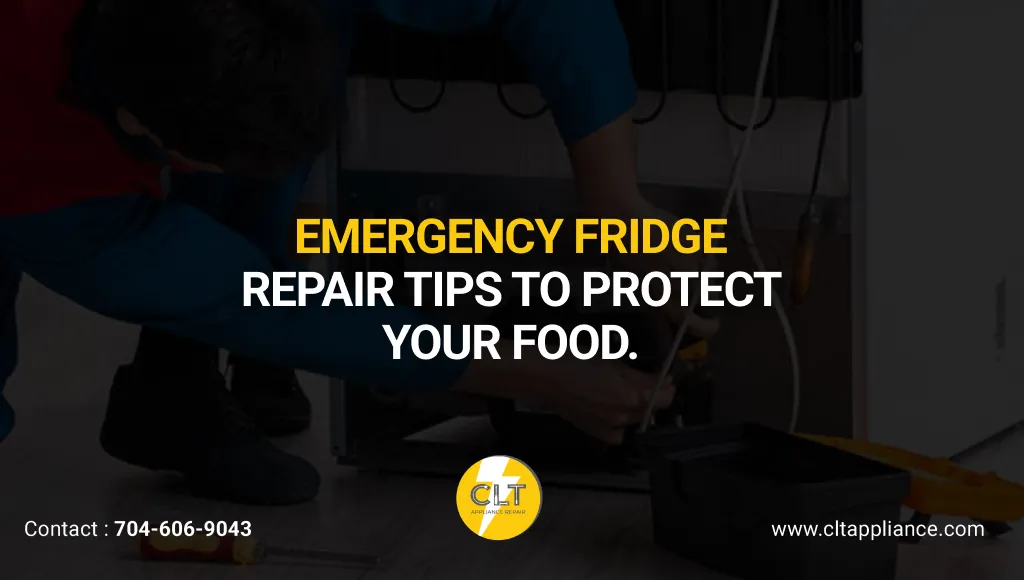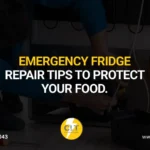A fridge failure puts your food at risk fast. Act quickly: keep doors closed. A closed fridge stays cold about 4 hours, and a full freezer about 48 hours (24 if half-full). Move high-risk items like meat, dairy, and seafood to coolers with ice right away. Monitor food with a thermometer and discard anything that’s been above 4°C (40°F) for more than 2 hours. Before calling a repair service, check the power, temperature settings, and condenser coils. Group freezer items together to hold the cold and use ice packs or a neighbor’s fridge for backup storage.
A refrigerator breakdown can quickly turn into a household emergency, especially with a full fridge. Every minute counts once cold air escapes and food temperatures rise into the danger zone. Knowing how to respond right away can mean the difference between saving your groceries and throwing everything out. While waiting for a refrigerator repair technician, simple actions can keep food safe longer. Some issues you can troubleshoot yourself, but others require a professional to prevent complete food loss. Acting fast protects both your health and your wallet.
Get emergency refrigerator service from CLT Appliance Repair with rapid response to prevent food spoilage and restore cooling immediately.
Give Us A Call – 704-318-4235
Why Immediate Action Matters During Fridge Failures
When your fridge stops cooling, temperatures rise fast, and bacteria grow even faster. Food can turn unsafe in just a few hours if no action is taken.
Tip 1: Ensure Safety First
When your fridge stops working, safety comes first. If you see any electrical issues like sparking, burning smells, or exposed wires, unplug it immediately.
Disconnect Power Immediately
Unplug the fridge first. This protects you from electric shocks while you check for the problem or deal with water around the appliance.
Assess the Situation Safely
After unplugging the fridge, check the basics: breakers, power cords, and nearby outlets. Test other appliances on the same circuit to see if it’s a house-wide power issue or just the fridge.
Identify Warning Sounds
Listen for unusual sounds before a breakdown, as they can be helpful clues for diagnosis. Sharp clicking patterns, persistent buzzing, or mechanical grinding typically signal compressor complications or motor degradation requiring professional refrigerator repair. Make a note or short recording of the strange sounds. This helps your technician figure out the problem faster.
Tip 2: Preserve Cold Air Retention
Keeping the cold air inside your fridge and freezer is the most important step during an outage.
Keep Doors Firmly Closed
Resist the urge to keep opening the fridge to check. Every time you open the door, you let cold air escape and make food spoil faster. Your food stays safe for about four hours in a closed fridge. But here’s the catch: every time you open the door, you lose that protection faster.
Strategic Door Opening Protocol
If you need to get food out, be smart about it. Before you open the door, gather what you need: coolers, ice, and containers. When you do open it, grab the risky stuff first: meat, dairy, and leftovers. These spoil fastest. Then get less sensitive items if there’s time.
Minimize Opening Time
Group similar foods and remove them in one quick trip to keep the fridge cold. Every extra second the door stays open lets warm air in and shortens the time your food will stay safe.
Tip 3: Transfer Perishables to Emergency Storage
Get a working fridge at a friend’s place or a cooler packed with ice. Move your perishables there while you wait for repairs. It’s the easiest way to keep everything safe.
Prioritize High-Risk Foods
Some foods spoil very quickly and must be kept cold right away to stay safe. Move these classifications immediately to ice-equipped emergency storage:
Foods Requiring Immediate Transfer
- Raw meat, chicken, and fish
- Milk, yogurt, cheese, and other dairy products
- Eggs and foods made with eggs
- Leftovers
- Cut fruits and vegetables
- Salads and deli meats
Emergency Cooling Solutions
Pack your perishable food into coolers with ice packs. Keep the ice right next to the food so everything stays cold. Use a thermometer to make sure it’s staying below 4°C (40°F) because that’s the safe zone.
Alternative Storage Options
- Ask a neighbor if you can use their fridge or freezer for a while
- Pack food into insulated bags or lunch boxes with ice packs
- Store food in a cold basement or garage only if it’s under 46°F (8°C)
- If repairs take longer, consider renting a portable fridge or freezer
- Buy dry ice for extra cooling power, as it lasts longer than regular ice
Dry Ice Safety Precautions
Dry ice gets colder than regular ice, but you have to handle it carefully. Never touch dry ice with bare hands, and keep the area ventilated since it releases gas as it melts. It can keep food cold for many hours if used safely.
Freezer Food Management
If your freezer stops working but everything’s still frozen, rearrange things to buy more time. Push all the frozen food together in the center. Packed-tight food stays frozen way longer than items scattered around.
Tip 4: Monitor Food Safety Guidelines
Know what to keep and what to toss. When in doubt about whether food is still safe, throw it out. The cost of replacing groceries is nothing compared to dealing with food poisoning.
Temperature Monitoring Essentials
Use a fridge thermometer to check the internal temperature regularly. Food kept below 4°C stays safe. If it rises above that for more than 2 hours, throw it out, as bacteria may have already started growing.
Foods That Must Be Discarded
Prolonged refrigeration failures render certain categories high-risk for pathogenic contamination requiring disposal:
Discard Immediately if Above 4°C for Over 2 Hours
- Raw or cooked meat, chicken, and seafood
- Processed meats and frankfurters
- Whole eggs and egg-based preparations
- Milk, soft cheeses, and other dairy products
- Custards, cream desserts, or whipped toppings
- Mayonnaise, seafood sauces, or creamy dressings should be kept once opened
- Cooked rice, pasta, potatoes, or other starchy foods
Foods That May Remain Safe
Some foods can handle short periods at warmer temperatures and may still be safe to eat.
Generally Safe Items
- Hard cheeses like cheddar or parmesan
- Butter, margarine, or shortening (if they don’t smell bad)
- Intact fruits and vegetables in their whole form
- Bakery products and grain preparations
- Ketchup, mustard, or other acidic condiments
Tip 5: Attempt Basic Troubleshooting
Doing some basic checks first can often fix common fridge problems before you need to call a repair technician.
Check Power and Electrical Connections
Make sure your fridge is properly plugged in and the outlet is working. You can test the outlet by plugging in another appliance, like a lamp or phone charger. Check your home’s electrical panel to see if a breaker has tripped, especially the one for the kitchen.
Verify Temperature Settings
Check the temperature settings. Maybe someone bumped the dial or hit the wrong button. Your fridge should be set between 2-4°C (35-40°F) and your freezer at -18°C (0°F). If you’ve got a dial, it should be around the middle setting.
Inspect and Clean Components
Clean the coils. The coils on the back or bottom of your fridge release heat. If they’re dusty, your fridge has to work harder, which can cause breakdowns. Unplug the fridge, vacuum or brush off the coils, and plug it back in.
Condenser Coil Cleaning Steps
- Maintain power disconnection throughout the procedure
- Identify coil locations (reference owner documentation)
- Deploy specialized brushes or vacuum attachments, removing buildup
- Execute thorough yet gentle cleaning, preventing damage
- Restore the electrical supply and evaluate the cooling improvement
Listen for Compressor Operation
After reconnecting the power, listen for the compressor. A working fridge makes a quiet, steady humming sound. Problematic indicators include:
Warning Sounds to Identify
- Repetitive clicking absent startup (relay component failure)
- Perpetual operation without temperature reduction (refrigerant escape)
- Absolute silence (electrical discontinuity or compressor death)
- Abrasive grinding or vibration patterns (mechanical degradation)
If these basic steps don’t fix the cooling within a couple of hours, call a professional to avoid losing all your food.
Tip 6: Know When Professional Help Is Essential
Some refrigerator problems are too complex for homeowners to handle. These issues require certified technicians with the right tools and expertise.
Clear Signs You Need Professional Repair
Certain signs mean the problem is serious and only a professional should handle it.
Critical Warning Signs
- Absent cooling despite verified power and proper configuration
- Abnormal frost development within freezer sections
- Interior or exterior water accumulation
- A strange chemical smell that could mean a refrigerant leak
- The compressor keeps running, but the fridge still isn’t cooling
- Problems with ice makers or water dispensers
Refrigerant and Compressor Issues
If your fridge has a refrigerant leak or compressor failure, only a professional can fix it. These problems require special tools and safe handling.
Cost Considerations and Replacement Decisions
The age of your appliance plays a big role when deciding between repair and replacement. With good maintenance, refrigerators can last for many years. However, if your unit is near the end of its lifespan, replacing it may make more sense than paying for costly repairs, especially if several parts are failing at once.
Preventing Future Refrigerator Emergencies
Regular maintenance and proper use greatly reduce sudden refrigerator failures and food spoilage.
Regular Maintenance Schedule
By taking care of your refrigerator consistently, you can extend its lifespan and avoid unexpected breakdowns.
Monthly Tasks
- Clean the inside of the fridge and toss expired food
- Clean door gaskets while inspecting the integrity
- Remove the drain obstruction preventing water accumulation
- Make sure the temperature settings are correct
Quarterly Tasks
- Extract condenser coil contamination via vacuuming or brushing
- Thoroughly evaluate gasket sealing performance
- Verify ice generation and water delivery mechanisms
- Write down or record any strange noises or performance changes
Annual Tasks
- Execute comprehensive interior deep cleaning
- Replace water filtration elements per the manufacturer’s schedules
- Check if the fridge is level and adjust the feet if needed
- Arrange professional maintenance evaluations
Optimal Operation Practices
How you use your fridge affects its durability and reliability. Avoid overloading shelves or blocking airflow, as both can prevent even cooling. Keep some space between items so cold air can circulate freely throughout the compartments.
Warning Signs to Watch For
Catching small issues early allows you to fix them before they turn into major problems or food loss. Watch for warning signs that your refrigerator may need attention.
Early Problem Indicators
- Progressive temperature elevation despite proper settings
- Extended compressor cycles or abbreviated operation patterns
- Ice formation on freezer interior surfaces
- Moisture condensation on exterior panels
- Abnormal operational acoustics
- Higher-than-usual electricity bills
Dealing with minor issues right away helps prevent them from becoming emergencies that require costly repairs or result in spoiled food.
Takeaway
When a fridge breaks down, quick action is key to keeping food safe and avoiding waste. The first few hours decide whether your groceries stay fresh or spoil, so acting fast is critical. Basic emergency steps include keeping the door sealed, moving perishables into backup coolers, and following food safety guidelines.
Because time matters so much during a breakdown, being prepared is essential. Having a trusted repair service, extra coolers and ice packs, and knowing food safety rules will help you stay ready if your refrigerator fails unexpectedly.
When your fridge fails, every minute counts. CLT Appliance Repair offers fast emergency service to prevent food spoilage and get your fridge cooling again. Our certified technicians can diagnose and repair most brands, often the same day, so you don’t lose groceries.
Get Immediate Help – 704-318-4235
FAQs
How long will food stay safe in a fridge after it stops working?
Sealed refrigerators preserve safe conditions for approximately four hours. Fully stocked freezers maintain appropriate temperatures for 48 hours, while half-capacity units sustain safety for roughly 24 hours.
What should be done first if the fridge breaks down unexpectedly?
Immediately seal doors, relocate vulnerable items to ice-filled coolers, and explore neighboring households for temporary refrigeration capacity if accessible.
Which foods should be thrown out after a fridge has been off for several hours?
Eliminate proteins, dairy, eggs, and previously heated items experiencing temperatures exceeding 4°C beyond two-hour thresholds, preventing foodborne illness.
Can dry ice or ice packs help keep food safe during a fridge emergency?
Affirmative frozen carbon dioxide and gel refrigerant packs sustain safe temperatures within refrigerators or insulated containers, substantially prolonging perishable preservation throughout emergencies.
What basic troubleshooting steps can I try before calling a repair technician?
Verify electrical supply, confirm temperature configurations, eliminate condenser coil contamination, and identify unusual compressor acoustics before engaging professional assistance.
Is it safe to store fridge food outside during an outage?
Exterior storage remains viable exclusively when ambient temperatures stay beneath 8°C, utilizing sealed vessels protected from wildlife and environmental contamination.
Author

- John Bennett
- John Bennett is a seasoned appliance repair specialist at CLT Appliance Repair, where he brings over a decade of technical expertise and a strong commitment to customer satisfaction. With a background in electrical and mechanical systems, John has built a reputation for reliable, efficient, and honest repair services across a wide range of household appliances-including refrigerators, washing machines, ovens, and more.








